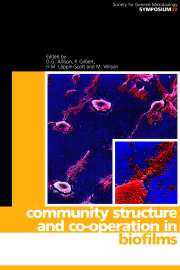Book contents
- Frontmatter
- Contents
- Contributors
- Editors' Preface
- An overview of biofilms as functional communities
- Initial microbial adhesion events: mechanisms and implications
- Physiological events in biofilm formation
- Environmental and genetic factors influencing biofilm structure
- Coaggregation and coadhesion in oral biofilms
- Cohesiveness in biofilm matrix polymers
- Microbial detachment from biofilms
- Modelling and predicting biofilm structure
- Microbial community interactions in biofilms
- Microbial communities: aggregates of individuals or co-ordinated systems
- Gene transfer in biofilms
- Population dynamics in microbial biofilms
- Biodegradation by biofilm communities
- Biofilms and prosthetic devices
- Biofilms: problems of control
- Biofilms in the New Millennium: musings from a peak in Xanadu
- Index
Microbial community interactions in biofilms
Published online by Cambridge University Press: 03 June 2010
- Frontmatter
- Contents
- Contributors
- Editors' Preface
- An overview of biofilms as functional communities
- Initial microbial adhesion events: mechanisms and implications
- Physiological events in biofilm formation
- Environmental and genetic factors influencing biofilm structure
- Coaggregation and coadhesion in oral biofilms
- Cohesiveness in biofilm matrix polymers
- Microbial detachment from biofilms
- Modelling and predicting biofilm structure
- Microbial community interactions in biofilms
- Microbial communities: aggregates of individuals or co-ordinated systems
- Gene transfer in biofilms
- Population dynamics in microbial biofilms
- Biodegradation by biofilm communities
- Biofilms and prosthetic devices
- Biofilms: problems of control
- Biofilms in the New Millennium: musings from a peak in Xanadu
- Index
Summary
INTRODUCTION
In nature, colonization of habitats by mixtures of bacterial populations is the rule rather than the exception. Diverse groups of micro-organisms are invariably isolated from samples from environmentally exposed habitats. Evidence is accumulating that such mixtures of organisms are not merely passive neighbours but that they are involved in a wide range of dynamic physical and metabolic interactions. Indeed, these interactions appear to be essential for the attachment, growth and survival of species at a site, and also enable organisms to persist in what often appear to be overtly hostile environments.
Such interacting mixtures of micro-organisms are termed microbial communities, and are generally found on a surface, spatially organized as a biofilm (see other chapters in this volume). Microbial communities have been described from habitats ranging from aquatic environments, anaerobic digesters, plant surfaces and soil particles, to the digestive tract of humans and animals. Although the nomenclature of the species from these diverse habitats is different, this chapter will demonstrate that the function (or niche; Alexander, 1971) of the community members is often similar.
Existence within a microbial community can have profound consequences for the component populations. These include (a) a broader habitat range for colonization, (b) an increased metabolic diversity and efficiency, so that substrates normally recalcitrant to catabolism by individual organisms can often be broken down by consortia to simpler products, (c) increased resistance to environmental stress and to host defence factors (Caldwell et al., 1997a, b; Shapiro, 1998) and, in some cases, (d) an increased ability to cause disease (pathogenic synergism; van Steenbergen et al., 1984; Brook, 1987a).
- Type
- Chapter
- Information
- Community Structure and Co-operation in Biofilms , pp. 167 - 198Publisher: Cambridge University PressPrint publication year: 2000
- 27
- Cited by



